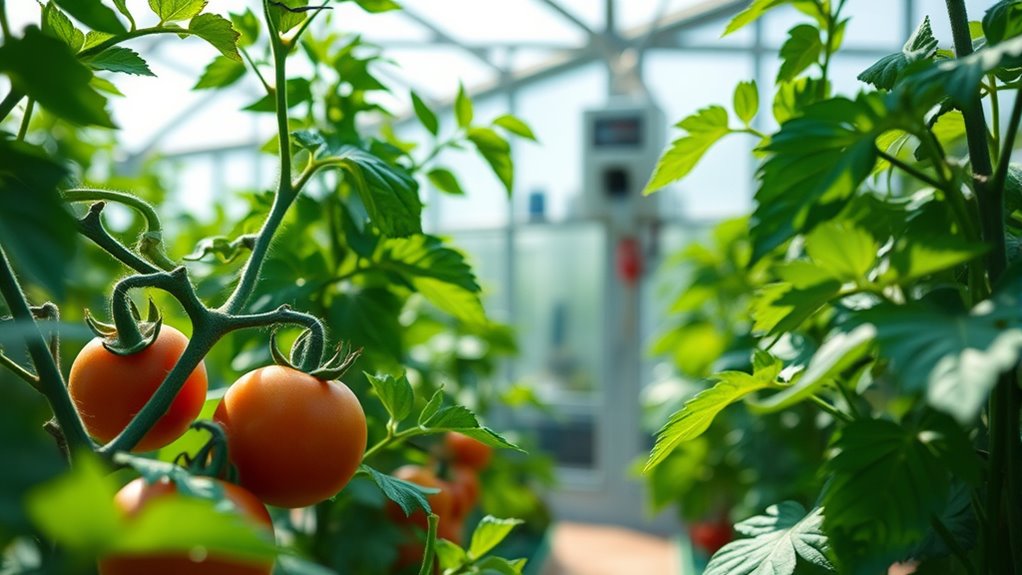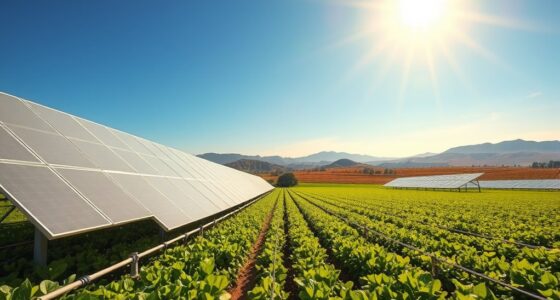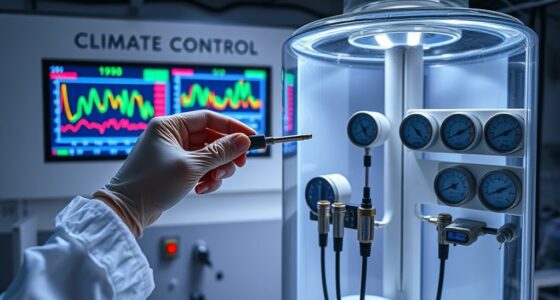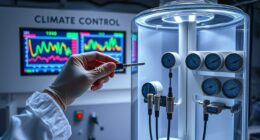Yes, IoT sensors can turn your greenhouse into a smart farm by providing real-time environmental data for automation and resource management. They help optimize plant growth, reduce manual work, and save energy by adjusting watering, ventilation, and lighting automatically. With continuous monitoring of temperature, humidity, and soil moisture, you’ll be able to improve crop health and yields efficiently. If you keep exploring, you’ll discover how these sensors can transform your greenhouse into a fully integrated, smart farming system.
Key Takeaways
- IoT sensors enable real-time environmental monitoring, automating adjustments for optimal plant growth.
- They facilitate automation of watering, ventilation, and lighting, transforming manual tasks into smart processes.
- IoT integration reduces resource waste and operational costs through precise control of water and energy use.
- Continuous data collection helps detect issues early, improving crop health and yield predictions.
- Connecting sensors creates a centralized, intelligent system that turns a greenhouse into a fully automated smart farm.

Greenhouses are increasingly turning to IoT sensors to optimize plant growth and streamline management. By integrating these sensors into your setup, you create a more efficient, responsive environment that adapts to your plants’ needs in real time. One of the key benefits is enhanced automation systems, which allow you to remotely control and automate vital functions like watering, ventilation, and lighting. Instead of manually adjusting every parameter, you can set your automation systems to respond automatically to sensor data, saving you time and reducing the risk of human error.
When you deploy IoT sensors for crop monitoring, you gain invaluable insights into your greenhouse’s microclimate. These sensors track temperature, humidity, soil moisture, and light levels, providing continuous data that helps you make informed decisions. For instance, if the soil moisture drops below a certain threshold, your system can trigger irrigation automatically, ensuring your plants receive consistent watering without waste. Similarly, if temperature or humidity levels fluctuate beyond ideal ranges, ventilation systems can activate to bring conditions back into balance. This real-time feedback loop means your crops stay healthier and grow faster, without the need for constant manual oversight.
The automation systems powered by IoT sensors also help you optimize resource use. By precisely monitoring environmental conditions, you avoid overwatering or excessive energy consumption. Sensors can detect when conditions are perfect, enabling you to operate equipment only when necessary. This not only reduces costs but also minimizes your environmental footprint. Furthermore, with centralized control platforms, you can access all data and manage your greenhouse remotely through your smartphone or computer, giving you flexibility and peace of mind.
Crop monitoring becomes more exhaustive with IoT sensors, providing a detailed picture of your plants’ health at any moment. You can track trends over time, identify issues before they become serious, and even anticipate future needs. For example, if sensors detect a slight drop in soil moisture, you can act proactively rather than reactively. This proactive approach helps prevent stress on your plants, leading to healthier crops and higher yields.
In addition, the use of high-quality sensors can significantly improve the accuracy of environmental measurements, ensuring your decisions are based on reliable data. In essence, IoT sensors empower you to transform your greenhouse into a smart farm. They integrate automation systems and crop monitoring into a seamless network that enhances productivity, conserves resources, and reduces manual labor. The technology provides real-time insights, allowing you to make smarter decisions quickly. As a result, you not only improve plant health and growth rates but also gain greater control over your entire operation. Embracing IoT sensors is a step toward modern, efficient, and sustainable greenhouse management that can truly elevate your farming game.
Frequently Asked Questions
How Much Do Iot Sensors Typically Cost for Greenhouses?
You’ll find IoT sensors for greenhouses typically cost between $50 and $300 each, depending on features like sensor calibration and data integration capabilities. Higher-end sensors often offer better accuracy and easier integration with your existing systems. When choosing, consider calibration needs to guarantee precise data, and check if they seamlessly connect to your data platforms. Investing wisely helps optimize your greenhouse conditions efficiently and cost-effectively.
What Are the Main Challenges in Implementing Iot Sensors?
Ever wondered what hurdles you might face with IoT sensors? The main challenges include ensuring accurate sensor calibration, so your data stays reliable, and seamless data integration across different systems. You’ll need to address connectivity issues and maintain sensor performance over time. Are you prepared to handle these technical details? Overcoming these obstacles is vital for turning your greenhouse into a truly smart farm, making automation efficient and effective.
Can Iot Sensors Operate in Extreme Weather Conditions?
You might wonder if IoT sensors can handle extreme weather conditions. The key is sensor durability and weather resilience; many sensors are built with rugged materials and protective casings to withstand harsh environments. While some sensors perform well in extreme heat, cold, or rain, you should always check specifications. Proper installation and choosing sensors designed for tough conditions guarantee reliable data collection, even during extreme weather.
How Secure Is the Data Collected by Greenhouse Sensors?
You might worry about data privacy, but rest assured, your greenhouse sensor data is quite secure. Manufacturers use advanced sensor encryption to protect your information from unauthorized access. While no system is completely invulnerable, implementing strong encryption and regular security updates markedly reduce risks. So, you can confidently rely on your IoT sensors, knowing that your data privacy is prioritized and safeguarded against potential threats.
Do Iot Sensors Require Specialized Technical Knowledge to Maintain?
You don’t need specialized technical knowledge to maintain IoT sensors, but some basic understanding helps. Regular sensor calibration guarantees accuracy, so you might need to learn simple calibration procedures. While advanced technical training isn’t necessary, familiarizing yourself with the system’s operation makes upkeep easier. With proper guidance, you can handle calibration and troubleshooting, keeping your sensors efficient without requiring extensive technical skills.
Conclusion
So, now that you know IoT sensors can turn your greenhouse into a “smart” farm, maybe it’s time to ditch that old watering can and let technology do the work. Who needs the charm of manual labor when you can have sensors telling you exactly when to water or adjust the temperature? Just sit back, relax, and enjoy your high-tech, supposedly “smart” farm—because what’s more natural than relying on gadgets to grow your food?










